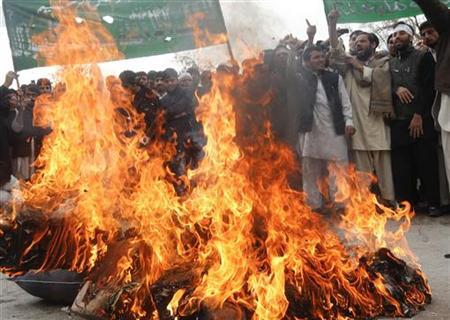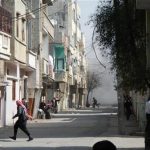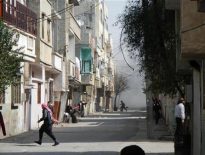By David Alexander and Rob Taylor
WASHINGTON/KABUL (Reuters) – President Barack Obama sought on Tuesday to dispel Afghan anger over a U.S. soldier’s massacre of 16 villagers even as protests erupted in Afghanistan over the incident and Taliban insurgents threatened to retaliate by beheading American troops.

The first protests over Sunday’s massacre flared in the eastern city of Jalalabad, where around 2,000 demonstrators chanted “Death to America” and demanded Afghan President Hamid Karzai reject a planned strategic pact that would allow U.S. advisers and possibly special forces to remain in Afghanistan beyond 2014.
Suspected insurgents opened fire on senior Afghan investigators looking into Sunday’s killing spree in Kandahar’s Panjwai district. They shot at long range at two of Karzai’s brothers, Shah Wali Karzai and Abdul Qayum Karzai, and security officials who had gone to the site of the massacre.
Karzai’s brothers were unharmed in a brief battle that began during meetings with local people at a mosque near Najiban and Alekozai villages, but a soldier was killed and a civilian wounded. The area is a Taliban stronghold and a supply route.
In Washington, Obama told reporters: “The United States takes this as seriously as if it was our own citizens and our own children who were murdered.” Obama administration officials also sought to dispel fears that U.S. war strategy was flawed.
Recent setbacks in Afghanistan have spawned calls to accelerate a 2014 goal for the exit of most foreign combat troops from Afghanistan.
British Prime Minister David Cameron said it is important to leave Afghanistan with the ability to provide its own security, but people also need to know the end is in view.
“I think people want an end-game,” Cameron told reporters on his plane before he arrived in the United States to visit Obama. “They want to know that our troops are going to come home. They have been there a very long time.”
U.S. officials said the Pentagon is focused on withdrawing by the end of this summer the remaining 23,000 “surge” troops Obama sent to Afghanistan in 2010, as the president has promised, and has not yet begun to plan for further withdrawals.
Obama said he told Karzai in a telephone call on Sunday that he was “heartbroken over the loss of innocent life” in the massacre, which left 16 dead, mainly women and children, and that the incident “is not who we are as a country and it does not represent our military.”
The Taliban threatened reprisals for the shooting spree, with spokesman Zabihullah Mujahid warning “the American animals that the mujahedeen will avenge them, and with the help of Allah will kill and behead your sadistic murderous soldiers.”
The killings were the latest in a spate of incidents this year that have inflamed tensions between the United States and Afghanistan. The burning of copies of the Koran by U.S. troops at NATO’s main base in Afghanistan provoked deadly riots and a series of shootings of U.S. troops by their Afghan counterparts.
There are about 90,000 U.S. troops currently in Afghanistan.
The White House and the Pentagon denied a New York Times report on Tuesday that the United States was reviewing options to withdraw an additional 20,000 troops by 2013.
U.S. Navy Captain John Kirby, a Pentagon spokesman, said the White House had made “no demands for options or recommendations” for withdrawing the 68,000 troops who will remain in Afghanistan once the surge troops are pulled out.
“The White House is not currently reviewing options for further troop withdrawals,” said White House spokesman Tommy Vietor.
U.S. lawmakers urged the administration to move ahead with the investigation quickly and transparently in order to help dispel Afghan anger. But they were divided over the impact of the incident, with some urging the administration to stay the course and others saying a speedier withdrawal was needed.
Senator John McCain, an influential Republican voice on military matters, said U.S. strategy should remain unchanged, but Obama should stop talking about withdrawal, which “discourages our friends and encourages our adversaries.”
ARMY INVESTIGATION
U.S. Army investigators continued to gather evidence in Sunday’s killings, in which a U.S. Army staff sergeant – reported to have only recently arrived in the country – is accused of walking off his base in the middle of the night and gunning down at least 16 villagers. The name of the accused soldier has not been made public.
In Washington, a U.S. official, speaking on condition of anonymity, said investigators were looking into whether alcohol was a factor in the shooting.
It was not immediately clear whether the accused soldier was believed to have been drinking at the time of the shootings or merely had alcohol among his possessions. U.S. troops are barred from alcohol use in the war zone.
On Monday, a U.S. official said the soldier had been treated for a traumatic brain injury suffered in a vehicle rollover in 2010 in Iraq.
The soldier, from a conventional unit, was based at a joint U.S.-Afghan base used by elite U.S. troops under a so-called village support program hailed by NATO as a possible model for U.S. involvement in the country after the 2014 drawdown.
Such bases provide support to local Afghan security units and provide a source of security advice and training, as well as anti-insurgent backup and intelligence.
A spokesman for Kandahar governor Tooryalai Wesa said tribal elders in the area of the massacre would urge against protests and work to dampen public anger if the investigation process was transparent.
“They are supporting the government and will accept any conclusion by the investigators. Today we have meetings with people in the area and all will become clear,” spokesman Ahmad Jawid Faisal said.
NATO officials said it was too early to tell if the U.S. soldier would be tried in the United States or Afghanistan if investigators were to find enough evidence to charge him, but he would be under U.S. laws and procedures under an agreement between U.S. and Afghan officials.
Typically, once the initial investigation is completed, prosecutors decide if they have enough evidence to file charges and then could move to a so-called Article 32 or court martial hearing.
NATO’s top commander in Afghanistan, Marine General John Allen, has promised a rapid investigation of the massacre, while security was being reviewed at NATO bases across the country.
U.S. Defense Secretary Leon Panetta said on Monday that the death penalty could be sought in the U.S. military justice system against the soldier, but portrayed the shooting as an isolated event that would not alter withdrawal plans.
While Afghan members of parliament called for a trial under Afghan law, Karzai’s office was understood to accept that a trial in a U.S. court would be acceptable provided the process was transparent and open to media.
U.S. forces invaded Afghanistan in 2001 to topple the Taliban rulers who had harboured the al Qaeda network responsible for the September 11 attacks on the United States.
(Additional reporting by Jack Kimball, Jeff Mason, Susan Cornwell and Matthew Falloon; Editing by Will Dunham)



